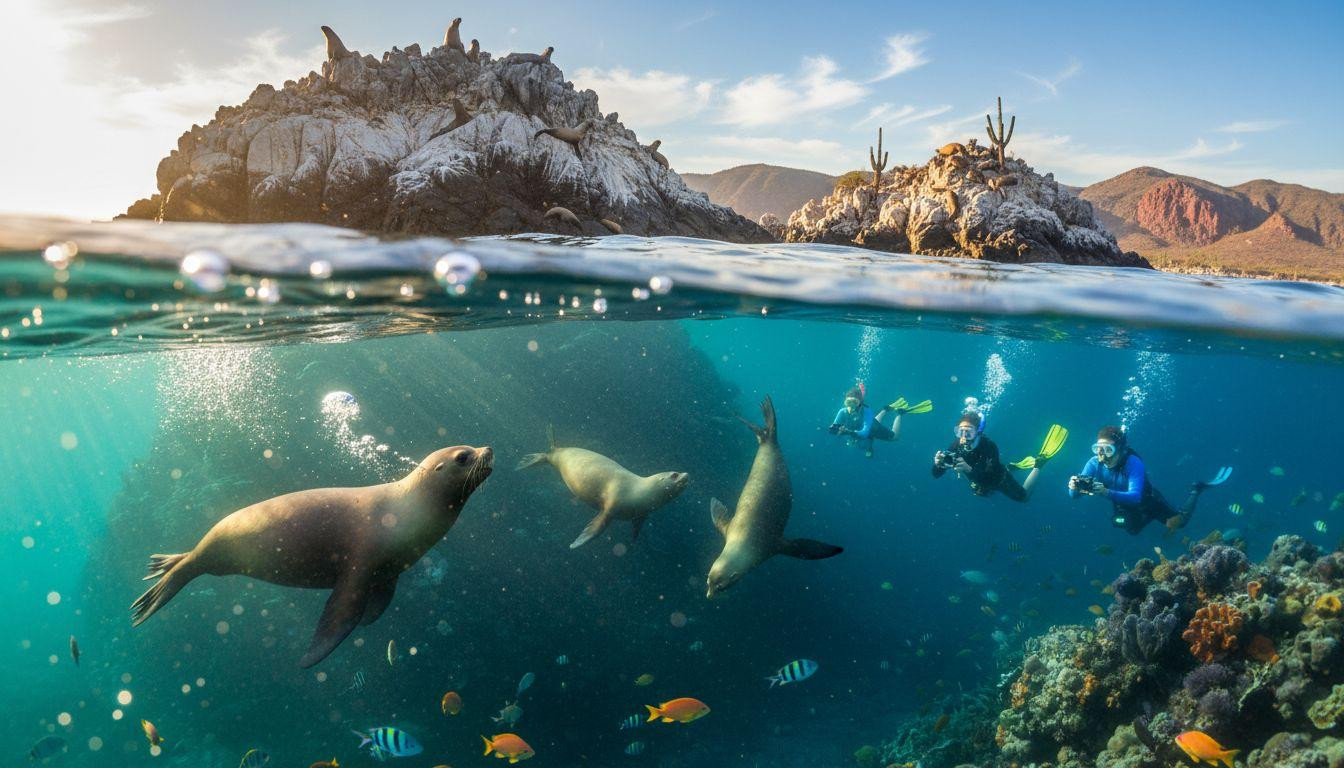Sea lions circle curious snorkelers at Los Islotes, their sleek bodies cutting through crystal-clear water just 45 minutes by boat from La Paz. This UNESCO-protected rocky outcrop hosts 400 California sea lions in the Sea of Cortez, where volcanic formations meet desert landscapes. While most Gulf of California sea lion colonies have collapsed by 65% since 1991, Los Islotes thrives as a conservation success story.
The island represents what protection can achieve when done right. Morning light reveals the stark beauty of this marine sanctuary, where sea lions swimming in protected waters create encounters impossible elsewhere in Mexico.
The Sea of Cortez’s protected jewel
Espíritu Santo Island stretches across 80 square kilometers of volcanic terrain 18 miles northeast of La Paz. The island earned UNESCO Biosphere Reserve status in 1995 and World Heritage Site recognition in 2005. Los Islotes sits at the archipelago’s northern tip, where nutrient-rich waters support the region’s largest sea lion breeding colony.
Local tourism boards confirm that visitor numbers are capped at 40% of ecological capacity. Only certified operators can access the site, with groups limited to 12 people per guide. This careful management preserves natural behaviors while allowing sustainable wildlife encounters.
The protection came after 1990s activism prevented casino hotel development. Conservation groups purchased the island and donated it to Mexico’s government, creating the legal framework that protects 562 species of marine life today.
Swimming with 400 wild sea lions
Los Islotes hosts between 400-500 California sea lions year-round, with approximately 170 pups born each June. The colony shows remarkable resilience while neighboring populations collapsed due to warming waters. Recent marine surveys reveal this site defied regional trends, actually growing while others declined by 40% between 2000-2018.
The underwater experience
Water visibility reaches 80-100 feet during November through March, peak season for underwater encounters. Sea lions demonstrate natural curiosity, often approaching snorkelers within arm’s length before darting away playfully. The rocky channels create underwater tunnels where juvenile sea lions race in graceful loops.
Morning departures at 7:30am from La Paz Marina offer optimal conditions. Volcanic island formations emerging from clear water frame each encounter, with cardón cacti towering 60 feet above desert shorelines.
Conservation in action
According to regional visitor centers, strict protocols govern all interactions. Boats maintain 150-foot distances from rookery areas during pupping season (May-August). Swimmers must stay 10 feet from resting sea lions on rocks, though animals often approach humans underwater.
The colony’s success stems from La Paz Bay’s unique oceanography. Local gyres maintain high biological productivity year-round, providing consistent food sources even as climate change devastates northern Gulf populations.
Beyond sea lions
Espíritu Santo offers diverse experiences beyond marine mammal encounters. The island’s volcanic origins created dramatic red cliffs contrasting with white sand beaches at Ensenada Grande and Bahía San Gabriel. Desert vegetation includes the world’s largest cactus species, creating surreal landscapes where arid terrain meets tropical waters.
Beaches and bays
Ensenada Grande’s protected bay offers calm snorkeling over coral reefs hosting 270 fish species. Kayak routes along the western shore provide access to hidden coves where blue-footed boobies and frigatebirds nest. Water temperatures average 75°F in November, ideal for extended swimming without wetsuits.
UNESCO protected marine wilderness designation ensures that development remains minimal, preserving the island’s pristine character.
Desert meets sea
The contrast between desert and ocean creates photography opportunities found nowhere else. Volcanic ash creates pink and gray cliff faces that glow at sunrise. Cardón cacti frame every vista, their massive arms reaching skyward against deep blue waters.
Hiking trails (when open) lead to 1,844-foot peaks offering panoramic views across the Gulf of California. Archaeological sites contain red-painted bones from 9,000-year-old indigenous settlements, though most areas remain closed to protect remaining artifacts.
Why protection enhances experience
The island’s conservation success creates authenticity that money cannot buy elsewhere. Wild sea lions exhibit natural behaviors because human impact remains carefully controlled. Animals show curiosity rather than the aggressive begging or fearful avoidance seen at unprotected sites.
Authentic fishing harbor experiences near protected areas in La Paz provide cultural context, where local fishermen have become conservation advocates after seeing tourism’s economic benefits.
Visitor surveys consistently rank Los Islotes among Mexico’s top wildlife experiences. The combination of accessibility (45-minute boat ride), protection status, and thriving wildlife creates encounters that feel both safe and genuinely wild.
Your questions about Espíritu Santo Island answered
How do I visit responsibly?
Book through certified operators only, available through La Paz tourism offices. Tours cost $80-150 per person and include snorkeling equipment, lunch, and certified guides. Advance booking is essential during peak season (December-April). Use only reef-safe sunscreen and follow guide instructions regarding wildlife distances.
What about the sea lions?
California sea lions are naturally curious but remain wild animals. They often approach snorkelers underwater but retreat if approached directly. Best viewing occurs during morning tours when animals are most active. Pupping season (May-August) offers opportunities to see mothers with young pups, though boat distances increase for protection.
How does this compare to the Galápagos?
Espíritu Santo offers similar wildlife encounters at 60% lower cost than Galápagos tours. While Galápagos receives 275,000 annual visitors, Espíritu Santo maintains stricter capacity limits with roughly 50,000 yearly visitors. Water visibility and temperatures exceed Galápagos averages, though species diversity is lower.
Dawn light transforms the sea lions’ rocky home into a theater of barks and splashes. Boats return to La Paz by afternoon, carrying visitors who’ve witnessed conservation’s power to preserve authentic wildness just minutes from civilization.
